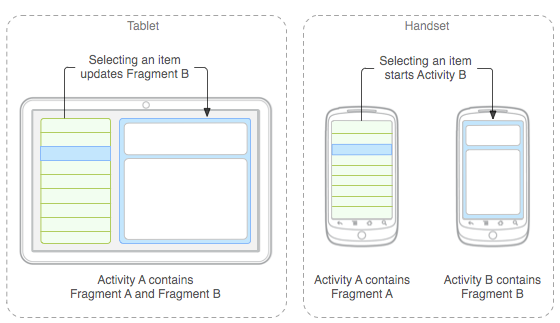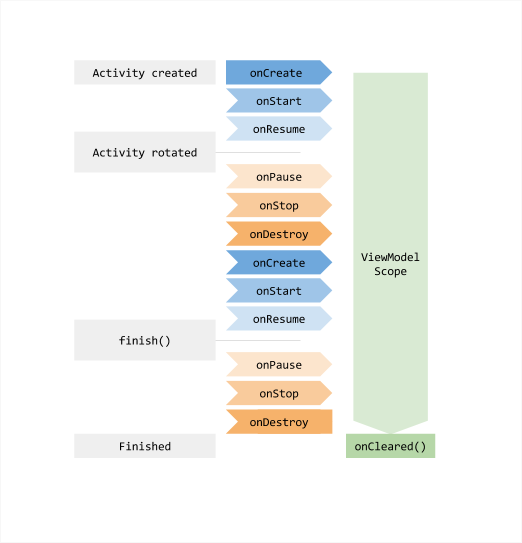- divide a program into separated sub-programs (features)
- independent, reusable and isolated
- unit of code to compile (i.e., Android Studio module)
- almost like React Component
- ease incremental builds and deliveries
- module is unit-testable
- modules can be added, modified or removed without any impact on one another
- modules can be reused
one of the fundamental building blocks
https://developer.android.com/guide/components/activities/index.html
- behind every screen stands a single
Activity
portion of user interface in an
Activityhttps://android-developers.googleblog.com/2011/02/android-30-fragments-api.html
The
ViewModelclass
- is designed to store and manage UI-related data in a lifecycle conscious way.
- allows data to survive configuration changes such as screen rotations.
https://developer.android.com/topic/libraries/architecture/viewmodel.html
fun onCreate(savedInstanceState: Bundle) {
// Create a ViewModel the first time the system calls an activity's onCreate
// Re-created activities receive the same MyViewModel instance
val viewModel = ViewModelProviders.of(this).get(MyViewModel::class.java)
}- First activity: fill a form to create a new operation
- Second activity: select a capable machine
With the help of Anko
findViewById<Button>(R.id.button_select_machine).setOnClickListener {
startActivityForResult<SelectMachineActivity>(
SELECT_MACHINE,
SelectMachineActivity.CAPABILITY to typeOfOperation
)
}findViewById<Button>(R.id.select_machine_a).setOnClickListener {
val intent = Intent()
intent.putExtra(MACHINE_ID, machineA.id)
setResult(
Activity.RESULT_OK,
intent
)
finish()
}
companion object Params {
val CAPABILITY = "SelectMachineActivity:capability"
val MACHINE_ID = "SelectMachineActivity:machineId"
}override fun onActivityResult(requestCode: Int, resultCode: Int, data: Intent?) {
if (requestCode == SELECT_MACHINE) {
if (resultCode == Activity.RESULT_OK) {
selectedMachineId = data?.getLongExtra(SelectMachineActivity.MACHINE_ID, -1)
}
} else {
super.onActivityResult(requestCode, resultCode, data)
}
}- Pros:
- stable
- many libraries written this way
- Cons:
- not composable (1 activity per screen)
- break the code flow (but rx to the rescue)
class SelectMachineFragment : Fragment() {
interface OnFragmentInteractionListener {
fun onSelectedMachine(selectedMachineId: Long)
}
}class CreateOperationActivity :
AppCompatActivity(),
SelectMachineFragment.OnFragmentInteractionListener {
override fun onSelectedMachine(selectedMachineId: Long) {
this.selectedMachineId = selectedMachineId
}
}class SelectMachineFragment : Fragment() {
private var listener: OnFragmentInteractionListener? = null
override fun onAttach(context: Context) {
super.onAttach(context)
if (context is OnFragmentInteractionListener) {
listener = context
} else {
throw RuntimeException(context.toString() +
" must implement OnFragmentInteractionListener")
}
}
override fun onDetach() {
super.onDetach()
listener = null
}
}override fun onCreateView(inflater: LayoutInflater,
container: ViewGroup?,
savedInstanceState: Bundle?): View? {
val view = inflater.inflate(
R.layout.fragment_select_machine,
container,
false
)
view.findViewById<Button>(R.id.select_machine_a).setOnClickListener {
listener?.onSelectedMachine(machineA.id)
}
return view
}class AnotherFragment : Fragment() {
fun updateUi(selectedMachineId: Long) {
TODO("update UI with selectedMachineId")
}
}class CreateOperationActivity :
AppCompatActivity(),
SelectMachineFragment.OnFragmentInteractionListener {
override fun onSelectedMachine(selectedMachineId: Long) {
val anotherFragment = supportFragmentManager.findFragmentById(
R.id.another_fragment_container_id
) as AnotherFragment
if (anotherFragment != null) {
anotherFragment.updateUi(selectedMachineId)
} else {
TODO("create and display AnotherFragment with selectedMachineId")
}
}
}- Pros:
- composable
- now compatible with the ACC ViewModel
- Cons:
- boilerplate code
- no compile-time checking
- Pros:
- native solutions are possible
- tried and tested
- Cons:
- troublesome to setup
- difficult to compose
- no navigation concerns
- sequential logic circuits
- finite number of states
- one state at a time (the current state)
- change from one state to another by triggering an event (a transition)
- the module fires an event,
- the hosting application receives this event and acts accordingly
- the flow is determined by events
- user actions, network requests, sensors, timer, other threads, etc.
Why EasyFlow
- simple to set up
- possible definition of a global context
- states definition through the
StateEnuminterface - events definition through the
EventEnuminterface - fluent API
- callbacks to perform specific jobs when entering or leaving a state
Fragmentto define a state of the application (i.e., a use case) and output event(s)Activityto manage states and how to navigate (i.e., the flow of events to change application state)
- Use of the ACC
ViewModel- Define and share a specific
ViewModelbetweenFragments
- Define and share a specific
- The hard case of Dagger 2
- Pros: code generation, hosted by Google
- Cons: many concepts to know and huge amount of code to write
- A nice way with Koin
- The global context of the FSM
class FsmContext : StatefulContext() {
val args = Bundle()
}- The shared
ViewModel
class FsmViewModel : ViewModel() {
val fsmModel: MutableLiveData<FsmModel> = MutableLiveData()
init {
fsmModel.value = FsmModel()
}
val flowContext: FsmContext
get() = fsmModel.value?.flowContext!!
fun trigger(event: EventEnum) {
flowContext.safeTrigger(event)
}
}- The FSM module
val fsmModule = applicationContext {
viewModel {
FsmViewModel()
}
}
object BackPressed : FsmEventclass UserInputModel {
val user: ObservableField<String> = ObservableField()
}class UserInputViewModel: ViewModel() {
val model: UserInputModel = UserInputModel()
val onSelectEvent = SingleLiveEvent<String>()
fun onSelectButtonClicked() {
onSelectEvent.postValue(model.user.get())
}
}<layout xmlns:android="http://schemas.android.com/apk/res/android">
<data>
<variable
name="model"
type="fr.guddy.kandroidmodular.userinput.mvvm.UserInputModel" />
<variable
name="viewModel"
type="fr.guddy.kandroidmodular.userinput.mvvm.UserInputViewModel" />
</data>
<LinearLayout
android:layout_width="match_parent"
android:layout_height="match_parent">
<EditText
android:layout_width="match_parent"
android:layout_height="wrap_content"
android:text="@={model.user}" />
<android.support.v7.widget.AppCompatButton
android:layout_width="match_parent"
android:layout_height="wrap_content"
android:onClick="@{() -> viewModel.onSelectButtonClicked()}"
android:text="@string/user_input_button" />
</LinearLayout>
</layout>class UserInputFragment : Fragment() {
/*...*/
override fun onCreateView(/*...*/): View? {
binding = DataBindingUtil.inflate(/*...*/)
return binding.root
}
override fun onActivityCreated(savedInstanceState: Bundle?) {
super.onActivityCreated(savedInstanceState)
viewModel = getViewModel()
fsmViewModel = getViewModelFromActivity()
binding.viewModel = viewModel
binding.model = viewModel.model
viewModel.onSelectEvent.observe(this) { user -> onSelect(user) }
}
private fun onSelect(user: String) {
if (TextUtils.isEmpty(user)) {
binding.editTextUser.error = getString(R.string.empty_user)
} else {
fsmViewModel.flowContext.userInputResult = UserInputResult(user)
fsmViewModel.trigger(UserFilled)
}
}
}- Define the module:
val userInputModule = applicationContext {
viewModel {
UserInputViewModel()
}
}- Start DI:
val allModules = listOf(
/*...*/
userInputModule
)
class MyApplication : Application() {
override fun onCreate() {
super.onCreate()
startKoin(this, allModules)
}
}
- The result data
@PaperParcel
data class UserInputResult(val user: String) : PaperParcelable {
companion object {
@JvmField
val CREATOR = PaperParcelUserInputResult.CREATOR
}
}With the help of paperparcel
- The module setup
object WaitingUserInput : FsmState
object UserFilled : FsmEvent
var FsmContext.userInputResult: UserInputResult
get() = args.getParcelable("UserInputResult")
set(value) {
args.putParcelable("UserInputResult", value)
}
fun FsmContext.clearUserInputResult() {
args.remove(_resultKey)
}class MainActivity : AppCompatActivity() {
private lateinit var fsmViewModel: FsmViewModel
private lateinit var flow: EasyFlow<FsmContext>
override fun onCreate(savedInstanceState: Bundle?) {
super.onCreate(savedInstanceState)
setContentView(R.layout.activity_main)
fsmViewModel = getViewModel()
buildFsm()
}// MainActivity.kt
private fun buildFsm() {
flow = from<FsmContext>(WaitingUserInput).transit(
on(UserFilled).to(ShowingUserRepos).transit(
on(BackPressed).to(WaitingUserInput)
)
)
// callbacks
flow.whenEnter(WaitingUserInput) { showUserInputFragment() }
flow.whenEnter(ShowingUserRepos) { context ->
showUserReposFragment(context.userInputResult.user)
}
flow.whenLeave(ShowingUserRepos) { context ->
context.clearUserInputResult()
}
// start with current state
flow.start(fsmViewModel.flowContext)
}
private fun showUserInputFragment() { /*...*/ }
private fun showUserReposFragment(user: String) { /*...*/ }// MainActivity.kt
override fun onBackPressed() {
if (supportFragmentManager.backStackEntryCount > 0) {
fsmViewModel.trigger(BackPressed)
supportFragmentManager.popBackStack()
} else {
super.onBackPressed()
}
}- relevant MVVM architecture
- power of the Kotlin language
- an elegant way to define the application flow
- no explicit coupling between screens
- increase testability
- test at module level (easy to stub injected dependencies thanks to Koin)
- test at application level
- adjustable to technical stack
- Extensions (functions, properties)
- Object declarations
- Delegated Properties
- Data classes
- Default and named arguments
- Syntax enhancement thanks to Kotlin
- Group redundant concerns in Java/Android libraries
- Expose features through a repository
- Front-end with drag&drop feature to build application flow?
- Kotlin: build iOS application and share common modules?
- React-native: write and share common modules (mobile and desktop)?
- Macoscope for many relevant articles
- Nicolas Chassagneux for many enriching discussions





